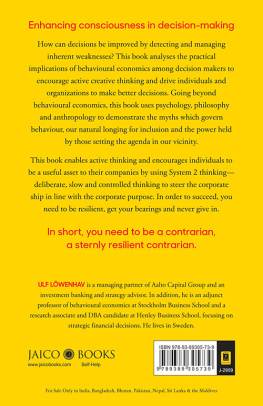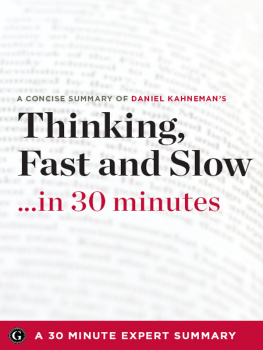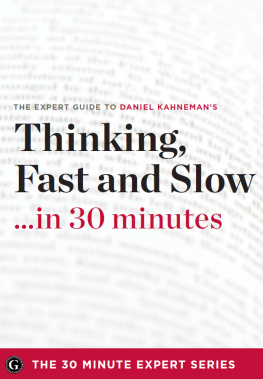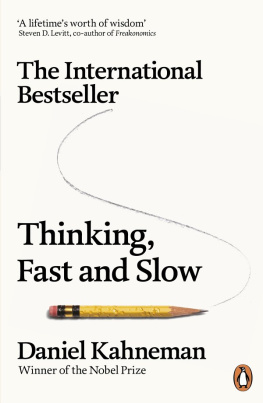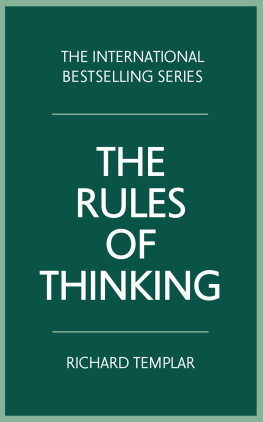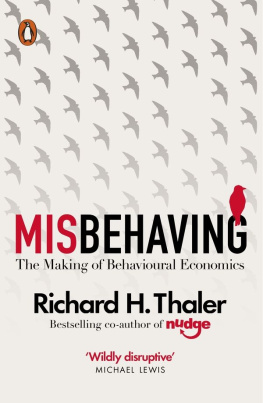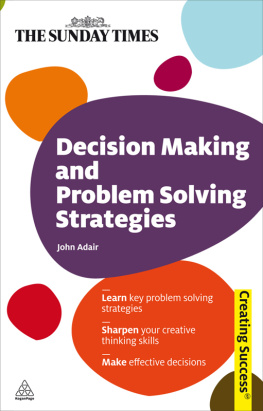
Published by Jaico Publishing House
A-2 Jash Chambers, 7-A Sir Phirozshah Mehta Road
Fort, Mumbai 400 001
www.Jaicobooks.com
2019 Ulf Lwenhav
Published in arrangement with
LID Publishing Limited
The Record Hall, Unit 304
16-16A Baldwins Gardens
EC1N 7RJ, London, UK
To be sold only in India, Bangladesh, Bhutan,
Pakistan, Nepal, Sri Lanka and the Maldives.
THE POWER OF ACTIVE THINKING
ISBN 978-93-89305-73-9
First Jaico Impression: 2022
No part of this book may be reproduced or utilized in
any form or by any means, electronic or
mechanical including photocopying, recording or by any
information storage and retrieval system,
without permission in writing from the publishers.
Contents
Introduction
This book is about change or, more to the point, how you can improve your decisions by detecting and managing your own inherent weaknesses.
During 2017, I enrolled in a new research project on boardroom performance at Henley Business School, where I investigated how important financial corporate decisions are processed. The background to my interest was that I for years had seen truly dysfunctional processes and decisions among all levels of corporate decisionmakers, people we would assume were truly professional. The process would start with managements preparations in the boardroom and finally presenting proposals to the shareholders. Focusing on a seemingly minor decision in this way was very revealing. First, the narrow focus enabled me to see the limited financial understanding on all the layers of an organization. I could see that for the study of a corporate environment, insights into psychology and sociology would become extremely useful, more so than knowledge of traditional business subjects. Second, it revealed that many decisions were poor, populistic and not founded in real business understanding. I think there has been a general assumption that established organizations are run in a professional way, which I had gradually realised is outright false. So, I wrote this book to enable students and decision-makers in corporations and organizations to see how weak and useless our decision making can be and how it can be possible to become more useful through the understanding of our environment.
This book addresses the practical implications of behavioural economics for real decision makers corporate managers and directors. It is based on my research at Henley Business School as well as on my experience of lecturing on behavioural governance at the Stockholm Business School. In these lectures, I used seminal work by Daniel Kahneman and Yuval Harari, in particular Thinking, Fast and Slow by Kahneman, which although a bit heavy reading for most students, can change people profoundly. Sapiens: A Brief History of Humankind by Harari also has the ability to make people revaluate their role in a bigger system. These texts, which give profound insights into our weaknesses and how to manage them, make people more reflective, humble and, I think, turn people into better decision-makers. My research shows that at times, managers base their decisions on theories they havent really understood, instead of considering who their key stakeholders are. For instance, many managers get their first introduction to finance in MBA programmes, without understanding the basic accounting and principles behind the key area of financial decisions.
Through my experience, I have discovered that many decision makers are looking for new inputs on decision making and for practical clues about how to get started. They have read new texts from the growing area of behavioural economics and feel they are gradually building a better understanding of their own shortcomings and biases, but they still need to see how to deal with their own situations and how to turn theory into a better daily behaviour.
Psychologists are aware that our brains are in different states of activity. Sometimes we are extremely relaxed. This is where we are most of the time and this has been called system 1. Sometimes we are actively engaged, which is system 2. Kahneman refers to system 1 as passive thinking, and system 2 as active thinking. What Kahneman calls system 1 characterized by our lack of true awareness and fast, passive, and often poor, decisions is a major problem for managers and key decision makers. System 2 the ability to pull oneself together, take a step back, and confidently enter into a room of active and more logical thinking is hard work. Being a contrarian in such situations and bringing something new to the discussions is often met with concerted resistance, and most people are uncomfortable with the social stigma it often results in.
Although we may understand system 1 thinking intuitively the application of it into management decision making is seldom done. Often, we like to think that we are aware and conscious thinkers without the necessary effort.
This book also addresses anthropological areas, in particular the concepts of myths and the power they convey; and neo-tribalism as a powerful explanation of our fears and general behaviour. My research shows that we are deeply affected by the tribes we live in and aspire to be part of. My belief is that tribalism is alive and kicking in organizations and once we see this invisible force, we may become better decision makers.
I have also entered into the realms of philosophy with regards to power structures and group self-control.
This text ends with the use of Kahnemans insights into decision making to exemplify an alternative route to analyse the context of a major decision.
Finally, the purpose of this book is to allow you to become a more active thinker, to force yourself into system 2, to steer the corporate ship in line with the corporate purpose and be a useful asset to your company. In order to succeed, you need to get your bearings and be resilient. In short, you need to be a contrarian, and a sternly resilient one.
The Power of Passive Decision Making: System 1
A reliable way of making people believe in falsehoods is frequent repetition, because familiarity is not easily distinguished from truth.
Daniel Kahneman
Imagine a situation where you are wrong about something that you have taken for granted. Well, this happens every day. Let me give you a universally understandable example.
Every day at the Louvre Museum, people spend hours queuing up to view the Mona Lisa painting. The truth is that the painting became well known after it was stolen from the Louvre by an Italian gentleman, Vincenzo Peruggia, in 1911. The painting was known in the art world as it was painted by Leonardo da Vinci, but Vincenzo managed to take the painting under his coat and walk out from the Louvre. Some two years after the theft, when Vincenzo was trying to make money on the painting, he was arrested, and the painting was sent back to Paris. Following this, several articles were published about patriotism and whether art by the Italian da Vinci should be in Italy, and so the painting with its warped smile became famous. So, the hordes of people lining up at the Louvre are passive thinkers. They misunderstand why the painting is famous and take it for granted that it is a masterpiece. An active thinker would gauge the art and make up their own mind.
Do we want to be part of that queue or should we make our own decisions?
The single largest challenge for a decision maker is to really think, therefore, to think actively. It is like the difference between sitting in the front seat of a car behind the steering wheel and sitting in the back seat. Sitting behind the wheel you control the car and actively guide the vehicle forward. In the back seat you may think you are part of the driving process, but the truth is that you can only watch what happens. For those who have read Daniel Kahnemans Thinking, Fast and Slow, this comes as no surprise, but simply knowing this difference doesnt make the challenge smaller or easier. Similarly, you can read and understand a book, but to see the real change you need to change your behaviour.
Next page
